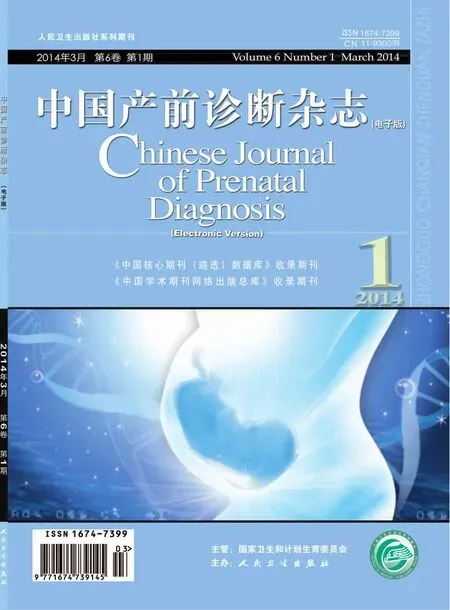“染色体核型正常的胎儿颈部透明带增厚和严重的先天性心脏缺陷循证分析”点评
陈佩文 陈欣林 赵胜 杨小红
(湖北省妇幼保健院超声诊断科,湖北武汉 430070)
“染色体核型正常的胎儿颈部透明带增厚和严重的先天性心脏缺陷循证分析”点评
陈佩文 陈欣林 赵胜 杨小红
(湖北省妇幼保健院超声诊断科,湖北武汉 430070)
1 原文摘要
Objective To pool published data regarding the sensitivity and specificity of nuchal translucency(NT)in the diagnosis of major congenital heart defects(CHDs)in fetuses with normal karyotype.
Methods MEDLINE and Scopus searches using combinations of the terms‘nuchal’and‘cardiac’were complemented by perusal of references of the retrieved articles and an additional automated search using the‘search for related articles’function on Pub Med.Only fetuses with normal karyotype and major CHDs were analyzed.Weighted estimates were made and summary receiver-operating characteristics curves were constructed.
Results The analysis included 20 studies(205 232 fetuses;537 cases with major CHDs). The pooled sensitivity and specificity of NT>95th centile for diagnosis of major CHDs was 44.4%(95%CI,39.5~49.5)and 94.5%(95%CI,94.4~94.6),respectively.The pooled sensitivity and specificity of NT>99th centile was 19.5%(95%CI,15.9~23.5)and 99.1%(95%CI,99.1~99.2),respectively.For the subgroup of studies in which NT was measured by Fetal Medicine Foundation-certified operators,the pooled sensitivity and specificity of NT>95th centile was 45.6%(95%CI,39.6~51.7)and 94.7%(95% CI,94.6~94.9),respectively.The corresponding estimates for NT>99th centile were 21.0%(95% CI,16.5~26.1)and 99.2%(95%CI,99.2~99.3).The pooled positive likelihood ratio for NT>99th centile was 30.5(95%CI,24.3~38.6). There was high across-studies heterogeneity for most estimates.
Conclusion Approximately 44%of chromosomally normal fetuses with CHDs have NT>95th centile and 20%have NT>99th centile.However,there is high heterogeneity across studies,which largely remains even in subgroup analyses of studies of apparently similar design,potentially indicating the presence of some residual unidentified bias.
2 论文核心内容及点评
该文章2013年9月于《Ultrasound Obstet Gynecol》杂志的网上发表。在该研究中,作者通过在胎儿核型正常、颈部透明带(NT)增厚、诊断为严重的先天性心脏缺陷(CHDs)的敏感性和特异性,对已发表数据的荟萃分析。主要内容如下:
这是一项数据汇集的循证分析研究。作者应用‘nuchal’and‘cardiac’的组合在MEDLINE和Scopus进行搜查,辅之以检索文章的参考文献,并应用Pub Med上的“搜索相关的文章”的功能。仅对胎儿正常核型及严重CHDs的进行了分析。进行加权评估,建立ROC曲线(受试者工作特征曲线)。
该分析包括20项研究(205 232个胎儿;537例有严重CHDs胎儿)。作者通过数据汇总,得出当NT值>第95位百分位数诊断严重CHDs的敏感性和特异性为分别44.4%(95%可信区间为39.5~49.5)和94.5%(95%可信区间为94.4~94.6)。NT值>第99位百分位数,诊断严重CHDs的敏感性和特异性为分别为19.5%(95%CI15.9~23.5)和99.1%(95%CI99.1~99.2)。其中由胎儿医学基金会认证的检查者测量的NT值,NT值>第95位百分位数,敏感性和特异性分别为45.6%(95%CI39.6~51.7)和94.7%(95%CI94.6~94.9)。相应的NT值>第99位百分位数敏感性和特异性分别为21.0%(95%CI16.5~26.1)和99.2%(95%CI99.2~99.3)。阳性似然比为NT值>第99位百分位数为30.5(95%CI24.3~38.6)。对于大多数的评估结果具有极大的变异性。
由此作者认为,染色体正常胎儿合并CHDs,约44%的其NT值>第95百分位数,约20%的NT值>第99百分位数。然而在相似设计的不同研究分析,仍然存在很大程度的变异性,表明其中存在一些潜在、不确定的偏差。
有充分的证据表明,在胎儿染色体核型正常,颈部半透明层(NT)增厚与胎儿结构异常的风险增加,最常见的先天性心脏缺陷(CHDs),严重先天性心脏结构异常与NT增厚呈指数相关。在以前的荟萃分析中,NT值>第95位百分位数和>第99位百分位数可以预测37%和31%的严重的CHDs。在确诊严重先天性心脏异常的四大胎儿超声心动图汇总分析中心,NT值的增厚使CHDs早期诊断提早了约6周。由于已经积累了大量的数据,且NT测量的标准化及更优化,使我们在孕早期对胎儿心脏解剖进行仔细观察,能更早的检测严重CHDs。因此,这一荟萃分析的目的是更新的证据,提示NT增厚和严重CHDs早孕期之间的关联。指导我们在临床中,早孕测量NT,更要关注胎儿的结构。

